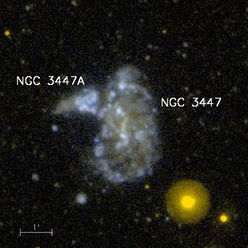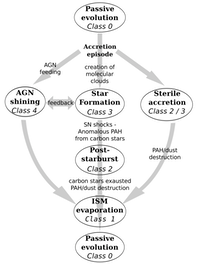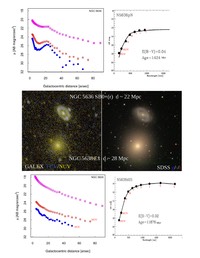The importance of groups comes mainly from two facts: (i) they contain most (~ 60%) of the galaxies in the Local Universe (e.g. Tully 1987, ApJ, 321, 280; Ramella et al. 2002, AJ, 123, 2976; Eke et al. 2004, MNRAS, 348, 866; Tago et al. 2008, A&A, 479, 927), (ii) the transition between galaxy properties typical of field and clusters happens just at the characteristic densities of groups, suggesting the existence of re-processing mechanisms acting before groups fall into clusters (Lewis et al. 2002, MNRAS, 334, 673; Gomez et al. 2003, ApJ, 584, 210).
Such re-processing mechanisms basically drive groups from an active (star-forming) phase to a more passive phase, typical of clusters (e.g. Goto et al. 2003, MNRAS, 346, 601; Gomez et al. 2003, ApJ, 584, 210). Some important physical parameters mark the difference between the possible evolution within groups and clusters. Among them, the galaxy velocity dispersion which in groups is comparable to the inner velocity dispersion of individual galaxies. Processes such as merging and accretions are much more effective in groups than in clusters (e.g. Zabludoff & Mulchaey 1998, ApJ, 498, L5; Blitz et al. 1999, ApJ, 514, 818). Conversely, mechanisms regulating galaxy evolution in the cluster environment, such as ram-stripping (e.g. Vollmer et al. 2002, Ap&SS, 281, 359) and galaxy harassment (Moore et al. 1999, MNRAS, 304, 465), are less relevant in groups.

PILOT STUDY We analyzed the group properties of three nearby groups, LGG 93, LGG 127 and LGG 225 (Garcia, 1993, A&AS, 100, 1) by means of an original proposal and archive GALEX data. These three groups are dominated by late-type galaxies (Marino et al. A&A 2010, A&A, 511,29).
SAMPLE DESCRIPTION Using approach and methods developed in the pilot study, we selected a wider sample of galaxy groups spanning a larger range of characteristics. We selected our sample of galaxy groups starting from the catalog of Ramella et al. (2002) which includes 1168 groups of galaxies and covering 4.9 steradians to a limiting magnitude m_B~15.5. The 6846 galaxies of the catalog were cross-matched with the GALEX and Sloan Digital Sky Survey (SDSS). For a detailed morphological and photometric analysis we chose only groups within 40 Mpc, composed of at least 10 galaxies. We selected a sample of 8 groups, with a number of members ranging from 10 to 47 and with a fraction of early-type galaxies varying from 20% to 70% of the galaxy population. Both UV and optical data are available for most galaxy members. We obtained new GALEX imaging of the remaining galaxies thanks to a successful proposal in the 6th NASA GALEX call (PI A. Marino). Thanks the wide-field UV imaging and large database of GALEX, we will be able to characterize the galaxy group activity of a well defined sample of galaxy groups.
RESEARCH DESIGN & METHODS From GALEX observations we will perform a luminosity weighted dynamical analysis of each group (harmonic radius and virial state; see Firth et al. 2006). This will characterize the "phase" of the group evolution on the same dynamical scale and will extend to far UV the member galaxies Spectral Energy Distribution (SED). Using population synthesis models we will derive the SFR for late-type members, hence evaluating the degree of activity as a function of the dynamical phase of the group. By modeling the SED we will derive the luminosity weighted "Age" of early-type members in the group. This "age", being an estimate of the recent activity occurred at the galaxy in terms of accretion/merging events, will be an additional information on the degree of the group evolution.
GLOBAL SIGNIFICANCE The work fits into vast the debate of the influence of the environment on the galaxy evolution. Clemens et al. (2009) suggest that, at any mass, early-type galaxies in low density environments, like groups, are younger of about 20% with respect to their cluster counterparts. Our aim is to join, for the first time, the history of the group, parametrized through the dynamical analysis, to the star formation history of galaxy members, ranking groups according to the their evolutionary phase.


